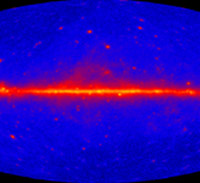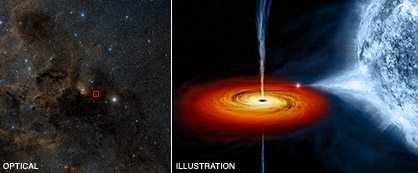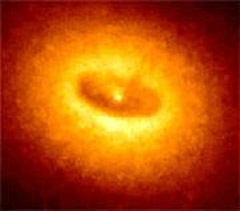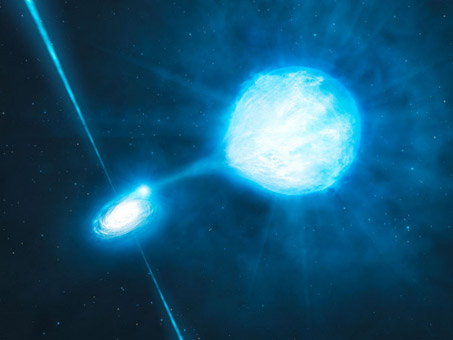Laboratory |
|
русский / english
|
Outstanding Problems of Gamma-Ray Bursts |
||
GRB ARE FULL OF OPPORTUNITIES TO STUDY THE EXTREMES OF RELATIVITY! What makes a GRB so much more violent and powerful than, for example, a supernova? GRB are different because they accelerate a giant stream of material in a relativistic jet. Gamma-ray emission measurements indicate that jet particle energy is boosted by thousands of times — a value called the Lorentz factor. This relativistic boost factor is so high, it is problematic for theory. We need to study these jets more to see if we have this right, or develop a better theory. At the very heart of the GRB, deep inside the explosion, is the ultimate power of this great cosmic explosion — a black hole formed in the explosion. Can we see signatures of a black hole? Is black hole formation the same in a GRB in the distant universe as in the more nearby universe?
Fig. 1. Gravitational waves are created from merging supermassive black holes and binary compact objects. Gravitational waves are expected to be detected by ground and space-based systems in the next decade. The Moon offers another stable platform on which to place detection instruments. Source: NASA
Fig. 2. The Extragalactic Gamma-ray background might encrypt in itself the signature of some of the most powerful and exotic phenomena in the Universe.
THE OPTICAL RISE OF GRB — A NEW FRONTIER! Optical telescopes coupled to X/gamma cameras have caused a revolution in GRB science starting with the first identified GRB around 15 years ago. Current GRB space observatories can respond to a gamma-ray trigger in less than a minute — but that’s far too slow to see the direct, unobscured emission from the jet in the optical. Only a small number of GRB observations include measurements of this early phase of GRB emission. This early optical emission allows us to independently measure the jet acceleration (see above — check the picture ), test ideas of GRB as standard cosmological indicators, see dust evaporate around individual stars to high redshift, compare physics of the emission in the gamma to that of the optical, and much, much more. This exciting variety of optical rise science is the reason the ExUL has set it’s sights on a space-borne observatory to measure the rise phase of GRB emission throughout the IR and optical, our ultra-fast response GRB satellite program.
Fig. 3. By observing massive stars of Cygnus X area of the milky way, the Large Area Telescope from Fermi spatial gamma observatory has captured emission of young cosmic rays.
Fig. 4. On the left, an optical image from the Digitized Sky Survey shows Cygnus X-1, outlined in a red box. Cygnus X-1 is located near large active regions of star formation in the Milky Way, as seen in this image that spans some 700 light years across. An artist’s illustration on the right depicts what astronomers think is happening within the Cygnus X-1 system. Cygnus X-1 is a so-called stellar-mass black hole, a class of black holes that comes from the collapse of a massive star. The black hole pulls material from a massive, blue companion star toward it. This material forms a disk (shown in red and orange) that rotates around the black hole before falling into it or being redirected away from the black hole in the form of powerful jets. (ref: Chandra)
SHORT GAMMA-RAY BURSTS, THE KEY TO THE COMING ERA OF GRAVITATIONAL WAVE ASTRONOMY! Soon the next generation of gravitational wave (GW) observatories will come on line, and the most likely first target they will see will be the Short-type gamma ray burst (SGRB). Like the first bodies discovered with optical telescopes, the first GW astrophysical sources will surely change our views of astrophysics and gravity physics, excitement without bounds for anyone who cares what’s «out there» in our universe. SGRB are believed to be pairs of neutron stars in their death throes. We have seen these systems loose energy, by watching their orbits slow down just as predicted by Einstein, and so infer the GW signal. What we have not seen, is the great, enormous, huge GW signal that occurs at the moment of death: when the two neutron stars — objects weighing as much as our star but so compacted by gravity they are smaller than a city — finally spiral into each other in a titanic explosion that results in the rapid, gamma-ray rich explosion of the SGRB. Like cosmic sirens warning of the cataclysm in progress, the GW signal will come to GW observatory. Like a blind man, however, the GW observatory can only «hear» the very crude, rough direction to the event — it is up to our space-born rapid observatory to see all the optical, IR, X, and gamma light form the explosion, and pinpoint the galaxy, system, and progenitor that will tell us the origin — still a mystery — of these events. Now, we will have electromagnetic signals from low to high energy, to cross correlate and examine with gravity signals all at the same time. Physics will never be the same with such richness of data from these multiple «messengers» from the cosmos.
Fig. 5. Like wine in a glass, vast clouds of hot gas are sloshing back and forth in Abell 2052, a galaxy cluster located about 480 million light years from Earth.
GAMMA-RAY POLARIMETERS WILL TAKE US FROM SPECULATION TO UNDERSTANDING! The most basic emission mechanism making all this emission from GRBs is thought to be synchrotron emission, energetic emission spiraling around magnetic field lines. So far, the confirmation of this mechanism, the basis of all theory, is elusive. Synchroton emission comes from energetic electroncs spiraling around magnetic field lines; a basic characteristic if this type of emission is that it is polarized. Therefore, measurement of the polarization of this emission should make for, finally, an easy confirmation of the theory. However, gamma-ray polarimetry is brand new, more difficult, and generally requiring larger instruments than simple gamma-ray measurements. Here at the EXUL and SINP, we are embarking on exciting projects to improve gamma-ray polarimeter design, building on our heritage with the GROME instrument.
Fig. 6. The newly identified quasar has been designated ULAS J1120+0641. It is not the most distant object seen in the Universe — that record probably goes to gamma-ray burst (GRB), the light from an exploded star. But the quasar is hundreds of times brighter than the GRB, and certainly bright enough to allow scientists to start to probe the object and its surroundings in some detail.
Fig. 7. The most distant black hole known is in the galaxy NGC 300, 6 million light-years away. Discovered in January 2010, the black hole is the first found to lurk outside the «Local Group» of galaxies to which the Milky Way belongs.
|
||









